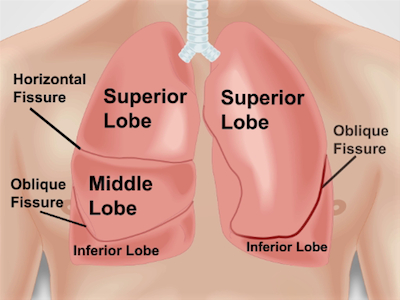Respiratory Exam II: Percussion and Auscultation
Source: Suneel Dhand, MD, Attending Physician, Internal Medicine, Beth Israel Deaconess Medical Center
Learning the proper technique for percussion and auscultation of the respiratory system is vital and comes with practice on real patients. Percussion is a useful skill that is often skipped during everyday clinical practice, but if performed correctly, it can help the physician to identify underlying lung pathology. Auscultation can provide an almost immediate diagnosis for a number of acute pulmonary conditions, including chronic obstructive pulmonary disease (COPD), asthma, pneumonia, and pneumothorax.
The areas for auscultating the lungs correspond to the lung zones. Each lung lobe can be pictured underneath the chest wall during percussion and auscultation (Figure 1). The right lung has three lobes: the superior, middle, and inferior lobes. The left lung has two lobes: the superior and inferior lobes. The superior lobe of the left lung also has a separate projection known as the lingual.

Figure 1. Anatomy of lungs with respect to the chest wall. An approximate projection of lungs and their fissures and lobes to the chest wall anteriorly. RUL - right upper lobe; RML - right middle lobe; RLL - right lower lobe; LUL - left upper lobe; LLL - left lower lobe.
1. Positioning
- Make sure the patient is undressed down to the waist.
- Position the patient on the examination table at a 30- to 45-degree angle and approach from the right side. Examining the posterior of the lung requires the patient to be leaning forward or sitting on the edge of the bed.
2. Percussion
- Percuss both posteriorly and anteriorly, starting on the back.
- Place non-dominant hand with middle finger (pleximeter finger) pressed and hype
Percussion and auscultation should always be done in sequence whenever performing a full respiratory examination. Learning how to percuss correctly takes time and practice (practice can be done on yourself or other surfaces, such as a table). Note how the percussion note changes naturally over air-filled lung, ribs, and solid organs, such as the heart.
Auscultation must be performed over each lung zone to give the physician the best chance of identifying the focus of any lung pathology. Abnorm
跳至...
此集合中的视频:

Now Playing
Respiratory Exam II: Percussion and Auscultation
Physical Examinations I
205.8K Views

General Approach to the Physical Exam
Physical Examinations I
112.2K Views

Observation and Inspection
Physical Examinations I
90.8K Views

Palpation
Physical Examinations I
80.9K Views

Percussion
Physical Examinations I
96.8K Views

Auscultation
Physical Examinations I
57.8K Views

Proper Adjustment of Patient Attire during the Physical Exam
Physical Examinations I
81.7K Views

Blood Pressure Measurement
Physical Examinations I
104.8K Views

Measuring Vital Signs
Physical Examinations I
112.2K Views

Respiratory Exam I: Inspection and Palpation
Physical Examinations I
150.5K Views

Cardiac Exam I: Inspection and Palpation
Physical Examinations I
171.5K Views

Cardiac Exam II: Auscultation
Physical Examinations I
136.8K Views

Cardiac Exam III: Abnormal Heart Sounds
Physical Examinations I
88.9K Views

Peripheral Vascular Exam
Physical Examinations I
66.6K Views

Peripheral Vascular Exam Using a Continuous Wave Doppler
Physical Examinations I
37.8K Views
关于 JoVE
版权所属 © 2025 MyJoVE 公司版权所有,本公司不涉及任何医疗业务和医疗服务。